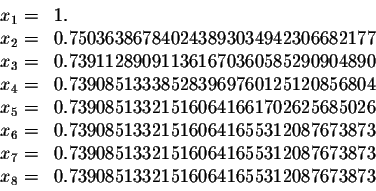
By Rick Stoll
|
By Rick Stoll |
|
|
Already the Babylonians knew how to approximate square
roots. Let's consider the example of how they found approximations to Let's start with a close approximation, say
x1=3/2=1.5. If we square x1=3/2, we obtain
9/4, which is bigger than 2. Consequently
We will do better if we take their average:
If we square x2=17/12, we obtain 289/144, which is bigger
than 2. Consequently
Let's take their average again:
x3 is a pretty good rational approximation to the square
root of 2:
but if this is not good enough, we can just repeat the procedure again and again. Newton and Raphson used ideas of the Calculus to generalize this ancient
method to find the zeros of an arbitrary equation
Their underlying idea is the approximation of the graph of the function f(x) by the tangent lines, which we discussed in detail in the previous pages. Let r be a root (also called a "zero") of f(x),
that is f(r) =0. Assume that
From the above picture, we see that x2 is getting closer to
r. Easy calculations give

Since we assumed

This process will generate a sequence of numbers This technique of successive approximations of real zeros is called Newton's method, or the Newton-Raphson Method. Example. Let us find an approximation to Note that
Let

Let us start this process by taking x1 = 2.

It is quite remarkable that the results stabilize for more than ten decimal places after only 5 iterations! Example. Let us approximate the only solution to the equation
In fact, looking at the graphs we can see that this equation has one solution.
This solution is also the only zero of the function

We have

Exercise 1. Approximate the real root to two four
decimal places of
Exercise 2. Approximate to four decimal places
Exercise 3. Show that Newton's Method applied to f(x)=x2-2 and x1=3/2 leads to exactly the same approximating sequence for the square root of 2 as the Babylonian Method. |
|
Send mail to m_engineer2002@netzero.com with
questions or comments about this web site.
|